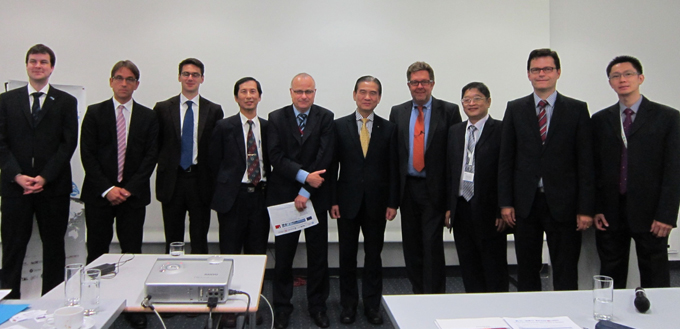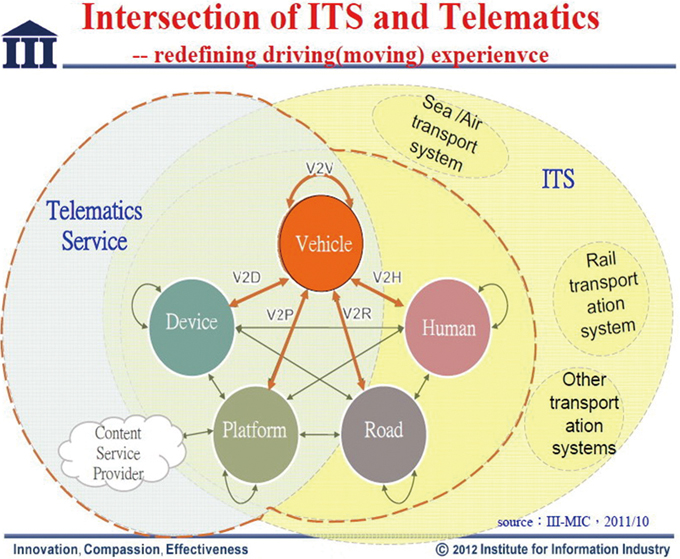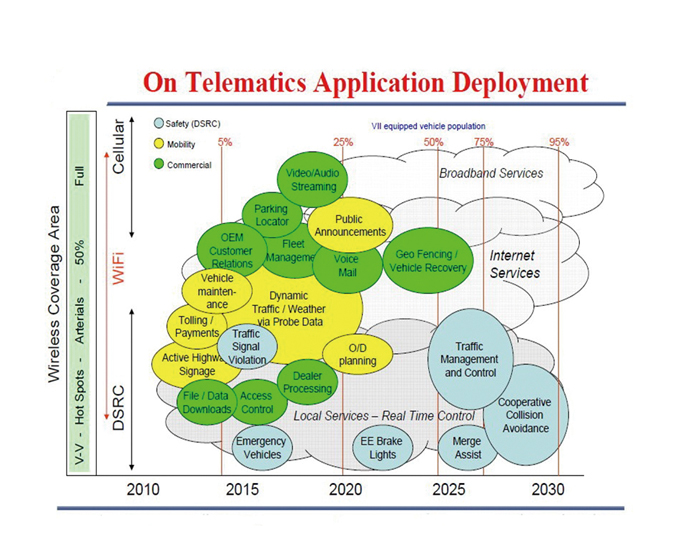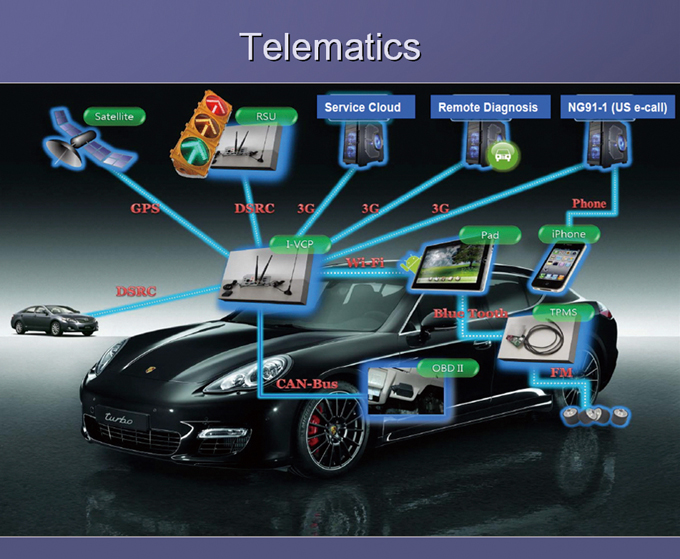Industry Expert Sheds Light on Telematics Development in Taiwan
New technologies offer safer, more convenient, and more comfortable travel
2013/10/04 | By Quincy Liang
One well-defined trend in the automotive industry today is the trend toward telematics, and Taiwan is well positions to ride the telematics wave.
With a well-developed information and communication technology (ICT) industry and strong support from the government, the island’s telematics industry is struggling to find the niche it needs to become a major player in the global market.
Dr. Frank Tsai, director of Smart Network System Institute, which is part of the Telematics Research & Technology Center of the government-supported Institute for Information Industry (III), is a key figure in the development of the local telematics industry. (Tsai is the Taiwan regional winner of the 2011 European Satellite Navigation Competition, also known as the "Galileo Masters," with an innovative smartphone app that facilitates local taxi dispatch management without the need for a centralized call center.) As a key promoter of the telematics industry in Taiwan, the director shed light on current and future developments in a recent interview with CENS.

What Is Telematics?
There are many definitions of telematics, Tsai said, but in general it is the integration of telecommunications, informatics, and automotive electronics to satisfy such needs as convenience, traffic information, communication, entertainment, safety, and business.
Telematics is closely linked to the intelligent transportation system (ITS), the infrastructure constructed by the government for land, marine, and air transportation to enable communication between moving vehicles and the infrastructure through ICT, sensing tools, and intelligent systems. The aim is to improve traffic congestion, environmental pollution, and other problems. Telematics is human- or/and vehicle-based and integrates technologies for linking people, vehicles, roads, mobile devices, and cloud service platforms to meet the requirements of the "smart life."

Quoting the findings of international research institutions, Tsai noted that the development and application of telematics are important in terms of energy conservation, carbon reduction, mobility upgrading, etc. In addition, telematics technology can make urban transportation smarter and more efficient, and can play a key role in developing new-energy vehicle and traffic-service applications. Telematics is, in this way, generating big changes in the automotive and related industries.
"All industrially advanced nations, most of which are also major automobile producers, have been aggressively developing telematics technologies focusing mainly on safety and security, energy efficiency, and convenience and comfort," Tsai pointed out, "while China's 12th Five-Year Plan for National Economic and Social Development (2011-2015) is also pouring lots of resources into related fields."
In 2016, about 90% of all new cars will be equipped with wireless-communication equipment, and the integration of vehicle, sensing, and mobile communication technologies is expected to soon create a "multi-giga mobile broadband connect" environment in our lives, Tsai said.

Development Blueprint
The major impetus for effective and rapid development of telematics technologies comes mainly from the development of ITS and intelligent vehicles, Tsai commented, so close cooperation between the government, industry, and academe is needed to maximize the potential efficiencies.
Tsai wants the government to pursue the advancement of telematics in Taiwan more aggressively so as to facilitate the development of homegrown telematics technologies, build the island into a demonstration region for most advanced telematics applications and services, and accelerate the movement of the local telematics industry into the global market (including China). "By leveraging Taiwan’s advantageous ICT industry,” he explained, "we have the chance to trigger an intelligent-traffic vogue and develop more value-added telematics services."
The first goal, according to Tsai, is to build up a comprehensive domestic telematics equipment supply chain so that Taiwan can become an important part of the global telematics equipment supply chain. This will enable Taiwanese suppliers to tap into the global market with strong competitiveness and create more production value for the island.
The second goal is for the government to help the local ICT industry effectively tie up with the automotive-electronics industry through its cloud-computing and big-data service capabilities. Such a tie-up, Tsai said, can help develop the telematics application segment in Taiwan. The third goal is to develop and set up related industry standards and build up the needed certification capacity for telemateics on the island, and the fourth is to form Taiwan into a sound vehicle-driving environment by providing various innovative intelligent-traffic application services.
Key focal points for the development of technology, Tsai said, include: vehicle-to-vehicle (V2V) safety technology, DSRC (dedicated short range communications) technology, green-transportation optimizing technology, and vehicle body network management and diagnostic technology. All of these technologies are needed to support the development of telematics total solutions, pinpoint market niches, and create new value. Their development can also promote vertical industrial integration, system integration, and international cooperation.
Vehicle-to-vehicle (V2V) communication technology provides a good example of the benefits of telematics, Tsai commented. By utilizing Intelligent Speed Adaptation (ISA), which informs, warns, and discourages the driver from exceeding the local speed limit, about 80% of all accidents caused by speeding can be avoided. The Front Collision Warning System (FCWS) can reduce collisions by 38% in urban areas and 75% on highways. DSRC technology can be used to transmit many different kinds of warning information to other nearby vehicles to help prevent accidents caused by such factors as lane departure, land changing, and emergency braking.
Benefits
Quoting statistics compiled by the Market Intelligence & Consulting Institute (MIC) of the III, Tsai reported that the annual production value of Taiwan's telematics industry reached NT$529.6 billion (US$17.65 billion) in 2012. The telematics-related product categories that are enjoying the fastest growth from 2011 to 2015 include camera/radar sensor products (with a compound annual growth rate of 49.4%), bureau-end and infrastructure construction (26.9%), and GPS smartphones (18.1%).
More and more local companies have become involved in the manufacturing of automotive-electronic products, Tsai noted, but the development of telematics services is still in its initial stage in Taiwan. So, he added, the most important thing now is to use the island's established advantages to develop new telematics application services; this, he said, will be the key factor in guiding future exports of Taiwan-made telematics products. So, Tsai stressed, there is an urgent need to facilitate such development by setting up telematics living zones on the island.
Some domestic research institutes have begun cooperating with local automakers in the development of vehicle safety and energy-saving technologies as well as cloud computing services for ITS, Tsai pointed out. Local automakers are evaluating the feasibility of setting up telematics service provider (TSP) subsidiaries and introducing new-generation telematics equipment in their new models.
Taiwan's GPS IC chip design enjoys initial global competitiveness for automotive applications, but is still facing competition from strong international suppliers. Tsai urged the government to provide support for the efforts of local IC designers to tap into the supply chain of the Global Navigation Satellite Systems (GNSS) developed in Europe.
In regard to telematics application services, Tsai conceded that local players still lack attractive value-added LBS (Location-based Service) applications, so that neither telecoms carriers nor content providers make money from that business despite Taiwan’s status as a major producer of personal navigation devices (PNDs).
In the future, Tsai suggested, local companies should bring different business models into the island through international cooperation projects so as to give locally-fitted LBS solutions a boost and inject growth momentum into the local telematics industry.
Tsai went on to say that cross-industry alliances are essential to the development of new telematics business models in Taiwan. For example, telematics solutions can help logistics companies set up a very efficient vehicle tracking and monitoring system, the data from which can be simultaneously transmitted to up- and downstream customers.
Besides setting up a public traffic management platform, Tsai says, the government should share the platform’s data and functions with users in the logistics, public transportation, digital broadcasting, and telecoms industries for the purpose of further extending the range of applications. And that, he added, will nourish the development of various types of TSPs.
In Taiwan, Tsai concluded, projects carried out by government agencies, research institutions, and private companies have gradually come to focus on the integrated development of telematics and intelligent urban transportation. We can expect to see more fruits of this development very soon.




